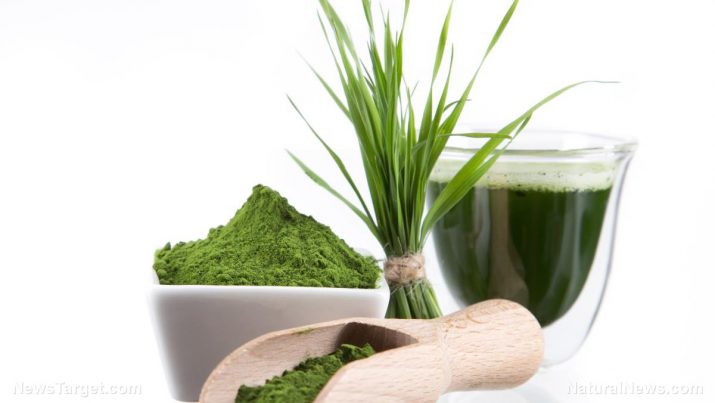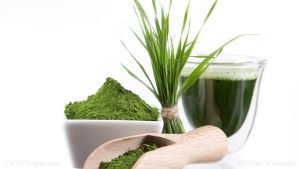
Wheatgrass – sources, health benefits, nutrients, uses and constituents at NaturalPedia.com
Thursday, July 06, 2017 by Jhoanna Robinson
http://www.naturalpedia.com/wheatgrass-sources-health-benefits-nutrients-uses-and-constituents-at-naturalpedia-com.html

Wheatgrass, which has the scientific name Triticum aestivum, is harvested before the wheat plant turns brown. Some 5,000 years ago, the Egyptians treated the wheatgrass plant as sacred.
The Western world first started eating wheatgrass in the 1930s; incidentally, this was also the first time that people learned of wheatgrass’ plenty nutritional benefits via the experiments that were conducted by Charles Franklin Schnabel who eventually became known as the father of wheatgrass and concluded that it was more nutrient-rich than alfalfa, broccoli, and spinach.

List of known nutrients
- Glutathione
- Iron
- Magnesium
- Protein
- Selenium
- Vitamin A
- Vitamn B
- Vitamin C
- Vitamin E
- Vitamin K
Medicinal uses for wheatgrass
Wheatgrass is extremely healthy for you; as a matter of fact, only two ounces of the herb already has all of the nutrients that are present in four pounds of organic vegetables. It has been proven that wheatgrass consumption contributed to overall beauty and wellness and increased energy levels.
Wheatgrass can address bowel and gastro-related problems as the fiber present in this herb can help prevent constipation, rejuvenate metabolic processes, and improve digestion. Also, because wheatgrass has a rich fiber content, it promotes weight loss.
Wheatgrass can guard against premature aging as it defends you from harmful carcinogens and free radicals. It helps fight certain cancers and slightly alleviate the plight of cancer patients, especially those who have liver, colon, stomach, and other types of gastrointestinal cancers.
Wheatgrass maintains the cleanliness of the liver. It can also be used to treat arthritis, as a 2012 study that was published in the International Journal of Pharmaceutical Sciences and Drug Research showed.
Wheatgrass can also ease lung deformities that have been caused by breathing acid gases such as carbon monoxide. Chlorophyll stimulates hemoglobin production which minimizes the effects of carbon monoxide in the body.
Wheatgrass can also lower blood pressure and improve capillary function. It can also increase red blood cell production, which is a good step towards an improved immune system, says nutritionist Carina Parikh. As a matter of fact, a 2004 study that was published in Indian Pediatrics showed that wheatgrass can lower the need for blood transfusions.
Wheatgrass can also enhance libido. Its high magnesium content enriches enzymes that control the proper function of sex hormones. Also, when you have a deficiency in magnesium, your body tends to crave sugar. Ingesting wheatgrass can reduce your food cravings, according to nutritionist Caroline Pearce.
Drinking wheatgrass juice for more than seven months can cause your acne and scars to clear up. Gargling wheatgrass juice for five minutes can also help relieve toothaches. Minor eye irritations can also be cured when you apply strained wheatgrass juice that is mixed with water to the affected eye part for 15 to 30 seconds. To eliminate dandruff, massage six ounces of wheatgrass juice mixed with water into the scalp and then let it soak the mixture soak into your head for 15 minutes.
Wheatgrass consumption also does wonders for your nails.
If your feminine area is experiencing itchiness and discomfort, you can use wheatgrass juice as a douche to alleviate your symptoms. Body odor is also reduced in people who have a daily diet of wheatgrass. Menstrual pain is also alleviated with the consumption of wheatgrass.
The selenium in wheatgrass can boost thyroid function, thereby addressing autoimmune diseases, a 2013 study published in Clinical Endocrinology showed.
Body systems supported by wheatgrass
Research scientist E. Bircher said chlorophyll, which wheatgrass is 70 percent made of, is “concentrated sun power”, and that it “increases the function of the heart, affects the vascular system, the intestines, the uterus, and the lungs”.
Wheatgrass – in liquid form – can detoxify the body. Drinking wheatgrass juice can remove toxins in the lymph nodes and mucus and drugs in the body, thus ensuring a healthy and disease-free body by curing colds, flu, and clogged sinuses.
Wheatgrass, which has alkaline properties, helps maintain the acidity and pH levels of the body. It also has anti-inflammation properties that can help reduce joint pain.
According to the Asian Journal of Pharmaceutical Technology, wheatgrass’ magnesium and vitamin K content improves the adrenal system, thereby helping you to properly manage stress. The iron in wheatgrass also helps prevent depressive symptoms.
Ways to use wheatgrass
Here are some wheatgrass green juice recipes.
Aside from being a delectable juice treat, wheatgrass can also serve as air purifier. Use it to renew the circulation of air in your office or place it near your bed so that it can provide a relaxing atmosphere that is conducive for a good night’s sleep.
Where to learn more
- Wheatgrass – a chlorophyll-rich superfood bursting with nutrients
- Wheatgrass Literally Can Turn Gray Hair Back to its Natural Colour & Slows Down Aging
- Wheatgrass: Prevents Cancer, Boosts Immunes System, Fights Arthritis & Detoxifies the Body
- Study: Wheatgrass Literally Has The Ability to Turn Gray Hair Back to its Natural Colour
- Healed by wheatgrass: 74-year-old man with cancer told he would be ‘dead in a matter of weeks’ provesw doctors wrong
Summary
Wheatgrass consumption does wonders for your nails.
Wheatgrass can detoxify the body.
Wheatgrass, which has alkaline properties, helps maintain the acidity and pH levels of the body.
Sources include:
Tagged Under: Tags: wheatgrass





